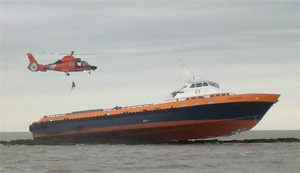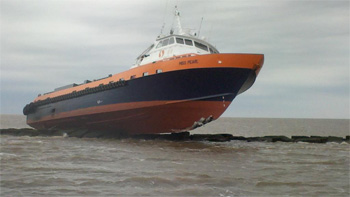The U.S. Coast Guard is investigating whether the bridge crew was paying attention when their offshore support vessel ran hard aground on top of the Sabine Jetties in clear weather, causing minor injuries and a fuel spill.
The 135-foot Miss Pearl was stuck on the rock jetty for a week after the accident, which happened shortly after 0600 on Feb. 24. The 3,160-hp vessel was inbound when it plowed into the barrier west of the breakwater.
 |
|
Courtesy U.S. Coast Guard |
|
A Coast Guard rescue helicopter evacuates the crewmembers. |
Miss Pearl’s operator, Seacor Marine LLC, calls the boat a “crew/fast support vessel.” Used mainly for oil crew transport, the vessel can carry as many as 62 passengers. The Coast Guard said Miss Pearl crashed during its return to Texas after a run out into the Gulf. Only the vessel’s four crewmembers were aboard.
A Coast Guard helicopter hoisted the four crewmembers off the rocks. Some were hurt, but no one needed hospitalization. The Coast Guard said about 4,000 gallons of diesel fuel spilled.
Although winds were 20 to 25 knots, the weather does not appear to have been a factor in the accident, said Bruce Davies, a Coast Guard senior investigating officer at Port Arthur.
“They were going to head up the Sabine-Neches (Waterway),” Davies said. “There was an electronic chart punched in the electronic chart system that would have guided them to the buoy at the breakwater.”
Earlier, the vessel was delayed in the Gulf because of poor visibility, but the weather cleared and the captain reported 10-mile visibility at the time of the accident.
“They were having problems with fog rolling in all the time,” Davies said. “They tied off at a rig because of the fog and rested for about three hours before they resumed the voyage. Then the fog cleared and the visibility was clear.”
Davies said the jetty area has a very narrow tidal range and there was a 1-knot current — nothing out of the ordinary. There were two people on the bridge: the captain plus one lookout.
The support vessel, built in 1993, has an operating speed of 25 knots. No mechanical or navigational equipment failed, and navigation aids were operating properly, Davies said. Considering the clear weather and accurate chart, investigators identified no obvious failure that might have caused the accident. Davies said he planned to question the captain again.
“The ‘why?’ and ‘how?’ are pretty puzzling right now,” Davies said in March. “What did the lookout see? What did the master see? What visual cues was he using when he was turning toward the jetties?”
The channel was temporarily closed during the response, the Coast Guard said.
A crane barge was hired to lift Miss Pearl straight up off the rocks. There was a tear in the hull, but the Coast Guard did not release specific information about the size of the hole or what repairs were necessary.
“The hull was definitely breached. It was significant, but it wasn’t catastrophic,” Davies said. “The damage on the vessel is not as extensive as you might think after running up on the jetties like that.”
Seacor employees referred questions to the Houma, La.-based company’s vice president and chief operating officer, Robert Clemons, who didn’t return phone messages requesting comment.

